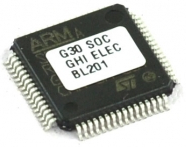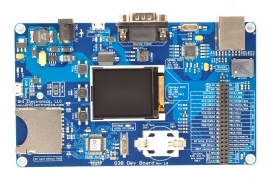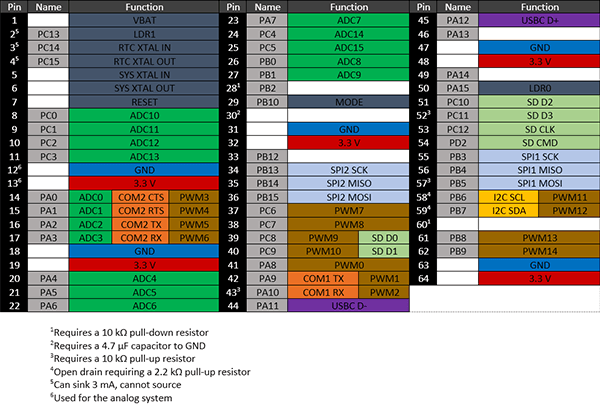G30

Overview
The G30 SoC is a low-cost System on Chip part of the GHI Electronics SurfaceMount Compute Modules (SCM) line. This modules can be programmed in .NET C# and Visual Basic using TinyCLR OS or .NET Micro Framework.
Pricing, purchasing and other information can be found on the G30 Page on our main website.
Ordering Part Number
- G30 SoC: 30SOC-SC-539
- G30 Dev Board: G30DB-SM-555
Specifications
| Spec | Value |
|---|---|
| Processor | STM ST32F401RET6 |
| Speed | 84 MHz |
| Internal RAM | 96 KByte (SRAM) |
| Internal Flash | 512 KByte |
| Package | LQFP64 10 x 10 mm |
| Temperature Range | -40C to +85C |
Note: Resources are shared between your application and the operating system.
Peripherals
- TinyCLR OS ready
- .NET Micro Framework
- RoHS Lead Free
- 84 MHz ARM Cortex-M4 STM32F401RET6
- 68 Kbytes available RAM
- 128 Kbytes available flash
- 49 GPIO
- 16 interrupt capable GPIO
- 2 SPI
- 1 I2C
- 2 UART
- 15 PWM
- 16 12-bit analog input
- 4-bit SD/MMC memory card interface
- Low power modes
- LQFP64 10 x 10 mm
- RTC
- Watchdog
- Threading
- USB client
- File System
- Full .NET file interface
- SD cards
- Native extensions
- Device register access
- Signal controls
- Generation
- Capture
- Pulse measurement
G30 Pinout
Many signals on the G30 are multiplexed to offer multiple functions on a single pin. Developers can decide on the pin functionality to be used through the provided libraries. Any pin with no name, function, or note must be left unconnected.
Footprint
The chip is standard LQFP64 10x10mm. See the ST32F401RET6 datasheet for exact footprint.
Device Startup
The G30 is held in reset when the reset pin is low. Releasing it will begin the system startup process.
There are three different components of the device firmware:
- GHI Bootloader: initializes the system, updates TinyCLR when needed, and executes TinyCLR.
- TinyCLR: loads, debugs, and executes the managed application.
- Managed application: the program developed by the customer.
Which components get executed on startup can be control by manipulating the LDR0 pin. It is pulled high on startup. When low, the device waits in the GHI Bootloader. Otherwise, the managed application is executed. LDR1 is reserved for future use.
Additionally, the communications interface between the host PC and the G30 is selected on startup through the MODE pin, which is pulled high on startup. The USB interface is selected when MODE is high and COM1 is selected when MODE is low.
The above discussed functions of LDR0, LDR1, and MODE are only during startup. After startup, they return to the default GPIO state and are available to use as GPIO in the user application.
TinyCLR OS
TinyCLR OS provides a way to program the G30 in C# or Visual Basic from the Microsoft Visual Studio integrated development environment. To get started you must first install the TinyCLR OS firmware (instructions below) and then go to the TinyCLR Getting Started page for instructions.
Loading the Firmware
- Activate the bootloader, hold the LDR0 signal low while resetting the board.
- Open TinyCLR Config tool.
- Click the loader tab.
- Select the correct COM port. If you are not seeing it then the device is not in the loader mode.
- Click the
Update to Latestbutton.
You can also update the firmware manually. Download the firmware and learn how to use the GHI Bootloader manually.
Start Coding
Now that you have installed the firmware on the G30, you can setup your host computer and start programming. Go to the TinyCLR Getting Started page for instructions.
Code Samples
For some examples of using TinyCLR, take a look at the TinyCLR Samples repo. You may also find the TinyCLR tutorials useful.
Native Code
TinyCLR OS also lets you use native code that works alongside your managed application. Native code can be used to provide improved performance or access to advanced features not exposed through TinyCLR. For more information check out Native Code on TinyCLR.
The memory area reserved for native code in TinyCLR OS on G30 starts at 0x20016000 and its length is 0x3F8.
.NET Micro Framework
It is possible to still use .NET Micro Framework (NETMF). Details are on the NETMF Introduction page. The NETMF Getting Started page covers NETMF from setup of the host computer to program deployment on both an emulator and target device.
Datasheet
This documentation page replaced the legacy datasheet PDF but it is here for reference.
Design Considerations
Required Pins
Exposing the following pins is required in every design to enable device programming, updates, and recovery:
- LDR0
- LDR1
- Reset
- Desired debug interface(s)
- MODE if required to select a debug interface
Power Supply
A typical clean power source, suited for digital circuitry, is needed to power the G30. Voltages should be within at least 10% of the needed voltage. Decoupling capacitors of 0.1 μF are needed near every power pin. Additionally, a large capacitor, typically 47 μF, should be near the G30 if the power supply is more than few inches away.
Crystals
The G30 requires an external 12 MHz crystal and associated circuitry to function. For the RTC to function, a 32,768 Hz crystal and circuitry are required. Please see the processor’s documentation for advanced information.
Interrupt Pins
Interrupts are only available on 16 pins at any given time. Of those 16 pins, the pin number must be unique. For example: PA1 and PB1 cannot both be used as interrupts at the same time, but PA1 and PB2 can.
Reset
The reset pin is not pulled in any direction. Designs must be sure to use an appropriate pull-up resistor.
G30 Development Board
The G30 Dev Board is an excellent starting point and reference design for anyone interested in evaluating and developing with the G30.

Legal
License
This product with its accompanying firmware are licensed royalty-free for commercial and noncommercial use. Using the provided firmware on a non-official product requires additional licensing. The provided documentation/schematics/libraries/sources are not to be used in any manner outside for the benefit of implementing and using this GHI Electronics product into your design.
Disclaimer
IN NO EVENT SHALL GHI ELECTRONICS, LLC BE LIABLE FOR ANY DIRECT, INDIRECT, INCIDENTAL, SPECIAL, EXEMPLARY, OR CONSEQUENTIAL DAMAGES (INCLUDING, BUT NOT LIMITED TO, PROCUREMENT OF SUBSTITUTE GOODS OR SERVICES; LOSS OF USE, DATA, OR PROFITS; OR BUSINESS INTERRUPTION) HOWEVER CAUSED AND ON ANY THEORY OF LIABILITY, WHETHER IN CONTRACT, STRICT LIABILITY, OR TORT (INCLUDING NEGLIGENCE OR OTHERWISE) ARISING IN ANY WAY OUT OF THE USE OF THIS PRODUCT, EVEN IF ADVISED OF THE POSSIBILITY OF SUCH DAMAGE. GHI ELECTRONICS LINE OF PRODUCTS ARE NOT DESIGNED FOR LIFE SUPPORT APPLICATIONS. SPECIFICATIONS, PRICE AND AVAILABILITY ARE SUBJECT TO CHANGE WITHOUT ANY NOTICE.
You can also visit our main website at www.ghielectronics.com and our community forums at forums.ghielectronics.com.
